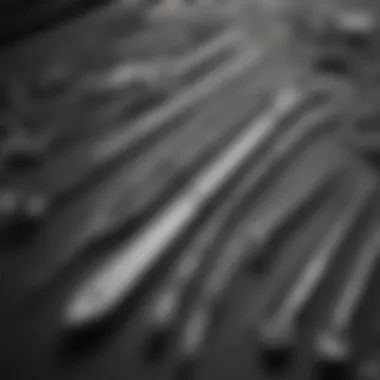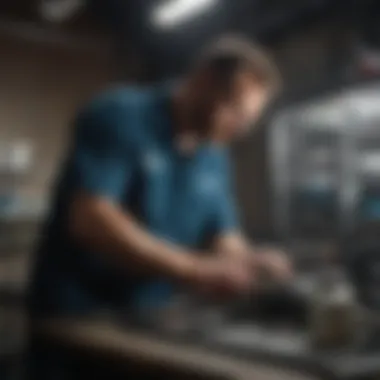Essential Accessories for Veterinary Technicians


Intro
Veterinary technicians play a crucial role in animal healthcare. To effectively carry out their tasks, it is essential to have the right accessories. These items not only enhance efficiency but also significantly improve patient care. Understanding the necessity of various tools and equipment helps professionals make informed choices, ultimately benefiting both their practice and the animals they care for.
Topic Overview
Definition and Importance
Veterinary technician accessories are the tools and equipment that assist professionals in delivering optimal care to animals. These accessories range from basic necessities, such as examination gloves and callipers, to advanced technology like digital stethoscopes and anesthesia monitoring devices. Their importance cannot be overstated, as they directly impact the quality of care provided.
Brief History and Evolution
The evolution of veterinary tools spans centuries. Long ago, techniques were rudimentary, with practitioners relying heavily on their hands and simple instruments. As veterinary medicine progressed, the need for specialized tools emerged. Today's veterinary technicians benefit from a wide variety of accessories that improve both efficiency and outcomes. Understanding this evolution gives context to the innovations available now.
Key Techniques and Innovations
In recent years, advancements in technology and sustainability practices have influenced veterinary work. Some key innovations include:
- Portable Diagnostic Tools: Devices like handheld ultrasounds allow technicians to perform assessments swiftly.
- Sustainability Practices: Eco-friendly materials in disposable supplies help reduce the environmental impact of veterinary practices.
- Telemedicine: Remote consultations are gaining popularity, requiring technicians to adapt their tools for virtual practice.
Practical Applications
Step-by-Step Guides
Effective use of accessories often requires detailed understanding. For example, mastering the use of a veterinary thermometer involves:
- Selecting the appropriate type (oral, rectal, or ear).
- Ensuring the device is clean and functional.
- Following proper procedure to avoid distressing the animal.
Case Studies or Real-World Examples
One notable example of effective accessory use is in surgical settings. Advanced surgical instruments have transformed procedures, leading to higher success rates and faster recovery times. Veterinary hospitals that have integrated these tools report improved patient outcomes and increased operational efficiency.
"The right accessories can make all the difference in veterinary practice, from routine exams to complex surgeries."
Prelude to Vet Tech Accessories
Understanding vet tech accessories is crucial for both veterinary technicians and the effective care of animals. These accessories are integral in daily operations, influencing efficiency and the outcome of patient care. As professionals who bridge the gap between veterinary medicine and patient handling, vet techs rely on various tools and accessories to support their role. Evaluating the right items involves considering both functionality and surgical integrity.
Accurate and efficient use of accessories can lead to improved workflows, ultimately benefiting practice management. In this section, we delve deeper into two primary elements: the role of vet technicians and the importance of proper accessories.
Defining the Role of Vet Technicians
Veterinary technicians, commonly recognized as the backbone of animal care, play an essential role in facilitating veterinary processes. They perform multiple functions, including preparing animals for surgical procedures, assisting in diagnostics, and ensuring that all medical protocols are followed. A vet tech’s work is not solely limited to hands-on animal care; they also engage in administrative duties, ensuring that all records are accurately maintained.
The comprehensive skill set of a vet tech includes not only animal handling but also understanding an array of medical equipment. Their training equips them to recognize which accessories can improve patient outcomes. This knowledge directly translates to better care standards and enhanced trust among pet owners.
Importance of Proper Accessories
Proper accessories are vital for veterinary technicians for several reasons. Firstly, they ensure safety—both for the animal and the technician. High-quality equipment minimizes the risk of injury during procedures. Secondly, efficiency is another significant factor. Using the right tools allows for smoother operations, especially in a high-volume clinic setting. It saves time and allows techs to focus on delivering quality care.
Aside from safety and efficiency, appropriate accessories contribute to better diagnostics and therapeutic interventions. For instance, having reliable diagnostic tools can lead to quicker and more accurate assessments, which in turn affects treatment plans positively. Moreover, proper accessories help in maintaining hygiene and adhering to sanitation protocols, which is crucial in preventing infections and ensuring a sterile environment.
Core Equipment for Vet Techs
The core equipment utilized by veterinary technicians is vital for their everyday practice. Each tool serves specific purposes, contributing significantly to efficient patient care and effective medical procedures. The right equipment can enhance the quality of service provided to animals, ultimately leading to better health outcomes. It is not just about having tools but also ensuring that they are appropriate for various situations encountered in veterinary practice. The focus here will be on two primary categories: surgical instruments and diagnostic tools.
Surgical Instruments


Scissors
Scissors are essential in any surgical setting. Their design varies based on usage, making them versatile for different tasks. One key characteristic is the sharpness of the blades, which allows for precise cuts during procedures. This accuracy reduces the risk of stress and trauma to the patient, making scissors a beneficial choice. A unique feature of surgical scissors is the option of curved or straight blades, which can be selected based on specific surgical needs. However, they require regular sterilization and maintenance to ensure continued functionality.
Scalpels
Scalpels are critical instruments in surgical procedures. They are designed for sharpness and precision, which is crucial for making incisions. The key characteristic of scalpels lies in their blade material, often made of stainless steel, ensuring durability during use. Their light weight is another advantageous feature, allowing for better maneuverability. Despite their many benefits, scalpels must be handled with care as they are easily damaged if dropped or improperly cleaned.
Forceps
Forceps are essential tools for handling tissue and other surgical elements. Their design allows for a firm grip, essential in delicate procedures. A major characteristic of forceps is their variety, with many types suited for specific tasks, such as holding or pulling tissues. This versatility makes them an integral part of every vet tech's toolkit. An advantage of forceps is their ability to minimize strain on the technician's hands during lengthy procedures. However, like other instruments, they necessitate proper sterilization between uses to prevent infection.
Diagnostic Tools
Stethoscopes
Stethoscopes are a foundational diagnostic tool in veterinary medicine. Their primary function is to amplify internal sounds, enabling the technician to assess the health of the animals. The key characteristic of a good stethoscope is its acoustic performance, which can impact the accuracy of the diagnosis. They are popular due to their relatively low cost and ease of use. While traditional models are effective, electronic options are also available, providing enhanced sound quality, although they can be pricier.
Thermometers
Thermometers serve as a basic tool for checking an animal's vital signs. The importance of accurate temperature measurement cannot be overstated in veterinary practice. The key characteristic of modern thermometers is their speed and precision. Digital models are generally favored due to their quick reading capability and ease of use. However, it is crucial to use reliable thermometers, as faulty ones can lead to misdiagnosis.
Ophthalmoscopes
Ophthalmoscopes play a key role in assessing the health of an animal’s eyes. These tools allow technicians to examine the interior of the eye, identifying conditions that may not be visible otherwise. A key characteristic is the light source that illuminates the eye, enabling a clear view. They are essential for providing comprehensive veterinary care, especially in anesthesia cases. However, effective use requires training, and improper handling can lead to damage.
Accessories for Patient Care
In veterinary practice, providing excellent patient care is vital. Accessories designed specifically for this purpose not only enhance the welfare of the animals but also streamline the process for veterinary technicians. The use of proper accessories ensures that procedures are safe, effective, and conducted with the comfort of the animal in mind. This section will discuss restraint equipment and comfort items, both essential in optimizing patient care in the clinic.
Restraint Equipment
Restraint equipment serves an important role in veterinary settings. It helps prevent injury to both the animal and the veterinary team during examinations and treatments. Proper use of restraint ensures that veterinary technicians can perform necessary procedures effectively.
Muzzles
Muzzles are a crucial tool for controlling animal behavior during treatment. They prevent biting and aggressive behavior, allowing the technician to perform tasks safely. The primary characteristic of muzzles is their design, which fits securely around the animal’s mouth without restricting breathing. They are a beneficial choice because they promote safety in potentially stressful situations. One specific feature of muzzles is the ability to design them for different breeds or sizes. However, some dogs may feel distressed while wearing muzzles, which can affect their overall experience at the clinic.
Leashes
Leashes are another fundamental accessory for patient care. They are used not only for walking dogs but also for control during examinations. The sturdiness of a leash is its key characteristic—ideally, it should resist pulling and provide a firm hold. This is beneficial in practice, as a reliable leash allows for better handling of anxious animals. Unique to some leashes are features like padded handles or retractable designs. Nevertheless, poorly made leashes can lead to accidents, making quality a critical consideration.
Restraint Bags
Restraint bags offer a different approach to handling animals. They wrap tightly around the animal, helping to restrict movement while ensuring comfort. The defining feature of these bags is their construction, which is both durable and breathable. This makes restraint bags a popular choice in situations where traditional methods may not work, such as with very small or stressed animals. Their advantage lies in the reduced risk of injury to both the animal and the staff. However, they require careful application and understanding of the animal's behavior to be effective.
Comfort Items
While managing an animal's safety, it is equally important to consider their comfort. Accessories that provide comfort can significantly impact the animal's experience and overall health. These items alleviate stress, helping to create a calmer environment during treatment.
Blankets
Blankets are essential in providing warmth and security to animals. They can be used for comfort during procedures or for recovery afterward. The key characteristic of blankets is their softness and insulative properties, which help to keep the animal calm. This makes them a beneficial and simple choice for various applications in the clinic. Some blankets may also be washable and designed for easy care. However, not all blankets are suitable for every animal, particularly those prone to overheating.
Heat Pads
Heat pads can be particularly beneficial for animals recovering from surgery or suffering from muscle pain. Their main attribute is the ability to provide consistent warmth, which promotes healing. Heat pads can be found in electric or microwaveable styles, making them versatile in different scenarios. Their use is increasingly popular due to their effectiveness in providing comfort. Yet, care must be taken to avoid overheating the animal, which can lead to burns.


Safety Collars
Safety collars play a crucial role in ensuring an animal's safety during treatment. Their design allows for quick release in emergencies, an essential characteristic that makes them a preferred choice in veterinary settings. Safety collars often come with reflective material or bright colors, aiding visibility. The unique feature is their adjustable size, suitable for various breeds. However, they must be properly fitted to avoid causing discomfort to the animal.
Important Note: Ensuring the right accessories are used can greatly enhance both safety and comfort during veterinary care, contributing to positive experiences for patients and technicians alike.
Hygiene and Sanitation Supplies
Hygiene and sanitation supplies are essential in veterinary practice. They contribute significantly to the safety of both the animals and personnel. Maintaining a clean environment helps prevent the spread of infections and ensures a higher standard of patient care. Proper sanitation protocols can mitigate health risks associated with zoonotic diseases, thus protecting both technicians and clients. The selection of the correct disinfectants, cleaners, and personal protective equipment is vital in achieving optimal health outcomes in any veterinary setting.
Disinfectants and Cleaners
Disinfectants and cleaners are the backbone of hygiene in veterinary practices. These products are designed to eliminate pathogens that can cause infections. Various surfaces such as examination tables, surgical areas, and waiting rooms should be regularly cleaned to ensure a safe environment. When choosing disinfectants, it is crucial to select those that are effective against common microorganisms found in veterinary settings. The EPA provides lists of approved disinfectants that are often beneficial. Furthermore, understanding the proper method of applying these products maximizes their effectiveness. Regular training on sanitation protocols for staff members also ensures compliance with safety standards.
Personal Protective Equipment (PPE)
Personal protective equipment plays a significant role in safeguarding the health of veterinary staff. PPE serves as a barrier against exposure to harmful substances and pathogens. The different types of PPE include gloves, masks, and aprons, each tailored to specific protective needs. Employing suitable PPE not only enhances safety for individuals but also promotes a culture of hygiene within the practice.
Gloves
Gloves are a fundamental aspect of personal protective equipment in veterinary medicine. They prevent direct contact with bodily fluids, thus reducing the risk of infections. A key characteristic of gloves is their single-use nature, which ensures that each interaction is hygienic. Latex gloves are popular due to their elasticity and comfort, while nitrile gloves are favored for their durability and resistance to punctures. Each type offers specific advantages, such as allergy-free options with nitrile. However, some gloves can cause skin irritation or may not fit all hand sizes well.
Masks
Masks are crucial for protecting the respiratory system from inhaling contaminants in veterinary clinics. They filter out pathogens and can prevent the spread of droplets that may contain infectious agents. A primary characteristic of masks is their ability to fit securely, providing effective coverage without hindering breathing. Surgical masks are advantageous as they are lightweight and disposable. However, not all masks offer the same level of filtration; hence, understanding the level of protection needed is essential. The downside is that prolonged usage can sometimes lead to discomfort.
Aprons
Aprons serve a protective function in the veterinary field, especially during procedures that involve messy tasks. They shield clothing from contamination, thus maintaining a professional appearance while ensuring hygienic protocols are followed. Commonly, aprons are waterproof, which adds an extra layer of protection against spills. The practicality of aprons is a significant advantage, making them an essential accessory in practices. However, the material used in aprons can impact their comfort and breathability, and there may be some limitations regarding size adjustments for different personnel.
"Maintaining hygiene is not just a practice, it is a commitment to health and safety in veterinary care."
In summary, hygiene and sanitation supplies, particularly disinfectants, cleaners, and personal protective equipment, are integral to veterinary practices. Each accessory must be carefully chosen and maintained to maximize safety and operational efficiency in caring for patients.
Office and Administrative Accessories
The realm of veterinary technology is not limited to hands-on animal care. Office and administrative accessories play a crucial role in ensuring the efficient operation of veterinary practices. These tools help in managing patient records, improving communication among staff, and enhancing overall workflow.
Record-keeping Tools
Veterinary Software
Veterinary Software is an integral component for modern vet clinics. It streamlines various administrative tasks, helping technicians and veterinarians access patient information with ease. A key characteristic of this software is its ability to consolidate record-keeping, billing, and scheduling into one platform. This makes it a beneficial choice for busy practices striving to improve service delivery.
One unique feature of many veterinary software options is their cloud-based functionality. This allows for easy access from multiple devices, enabling staff to update and retrieve information in real-time. However, while cloud systems offer convenience, they also require reliable internet access.
Patient Charts
Patient charts hold immense value in veterinary practices by ensuring that all relevant information about animals is documented and accessible. They typically include sections for medical history, treatment plans, and medications. The primary benefit of patient charts lies in their organization, allowing veterinary technicians to provide informed care quickly.
A unique feature of patient charts is the adaptability they offer. Whether digital or paper-based, these charts can be tailored to reflect the specific needs of a practice. However, reliance on paper charts can lead to issues such as lost data or difficulty in accessing current information quickly.
Communication Tools
Two-way Radios
Two-way radios are vital in a fast-paced veterinary environment. They facilitate instant communication among team members, which is essential during surgeries or emergencies. Their key characteristic is their immediacy, allowing for quick updates and alerts that enhance teamwork.


One of the unique features of two-way radios is their durability and ability to function in different environments, both indoors and outdoors. This makes them a popular choice in diverse settings. On the downside, they may require licensing or have a limited range compared to mobile devices.
Mobile Devices
Mobile devices, including smartphones and tablets, have transformed communication methods in veterinary practices. They provide easy access to information, enable on-the-go communication, and support various apps designed specifically for veterinary needs. This versatility makes them an essential accessory for veterinary technicians.
A unique feature of mobile devices is their connectivity to the internet, which allows access to online resources and real-time updates. However, this also means that staff must manage battery life and ensure devices are maintained to avoid disruptions during busy hours.
Choosing the Right Accessories
Selecting the appropriate accessories is crucial for veterinary technicians. The right tools not only boost efficiency but also impact patient care positively. Vet technicians must navigate a broad range of options when it comes to accessories. This involves evaluating which items fit their specific needs and the environment they work in. Accessory choices can greatly affect the workflow, the quality of care provided, and even the overall satisfaction of the veterinary team. Understanding what to prioritize when choosing these accessories can minimize stress in the day-to-day operations of a veterinary practice.
Assessing Quality and Durability
Quality and durability of accessories must be at the forefront of any selection process. Cheap tools are tempting, but they often lack longevity and reliable performance. Investing in high-quality accessories can lead to long-term savings and reduced replacements. For example, surgical instruments made from stainless steel often prove more durable than cheaper alternatives. Furthermore, durable tools can withstand frequent use and rigorous cleaning protocols without losing functionality.
When evaluating quality, it's also essential to consider the manufacturer's reputation. Trusted brands like McKesson and World Animal News often have rigorous standards and quality checks in place. Reading reviews and seeking recommendations can guide one toward the best options. Accessories that may require more testing over time include surgical drapes and anesthesia equipment. Always consider the stress these accessories will endure in a busy practice.
Budget Considerations
Choosing accessories always involves budget constraints. A higher cost may reflect better quality, but it’s imperative to find a balance. Prioritizing key accessories that directly impact patient care or safety justifies the expense. Common budget considerations include:
- Initial Investment: High-quality items usually demand a larger upfront cost. However, they can mitigate future expenses on replacements.
- Maintenance Costs: Some accessories require ongoing maintenance, adding to their total cost of ownership.
- Utility: Investing in multi-functional tools can optimize your budget. A single diagnostic tool that serves several purposes often makes more economic sense than purchasing separate tools for each function.
Finding the right balance between cost and quality can be challenging but essential for effective practice management. Engage with fellow professionals to share insights on budget-friendly brands and accessories that stand the test of time.
"Assessing quality and evaluating budget constraints are imperative steps in choosing accessories that will improve practice efficiency and quality of patient care."
By thoughtfully considering these aspects, veterinary technicians can make educated decisions, thus enhancing their practice's capabilities.
Maintenance of Vet Tech Accessories
Proper maintenance of vet tech accessories is crucial for ensuring optimal operation and longevity of these tools. The performance of a veterinary technician heavily relies on the efficiency and reliability of their equipment. Well-maintained accessories can significantly affect patient outcomes, streamline workflow, and improve overall clinic productivity. Regular upkeep creates a safer work environment and minimizes the risk of equipment failure during critical procedures.
Cleaning Protocols
Cleaning protocols are an essential aspect of maintenance. Following systematic cleaning procedures can prevent contamination and prolong the life of the equipment. Here are some key points regarding effective cleaning:
- Regular Schedule: Establish a routine cleaning schedule based on usage frequency. Instruments used on animals should be cleaned after each use.
- Appropriate Cleaners: Use veterinary-approved disinfectants. Not all cleaners are suitable for every type of instrument.
- Manual Scrubbing: For items that require it, manual scrubbing is important. Pay attention to serrated instruments or those with joints, where dirt can accumulate.
- Ultrasonic Cleaners: Consider ultrasonic cleaning machines for delicate instruments. This method offers deep cleaning without manual scrubbing, which can cause wear.
- Follow Manufacturer's Instructions: Always adhere to manufacturer guidelines for cleaning. Some items may require specific techniques or chemicals.
Storage Solutions
Proper storage solutions play a significant role in maintaining vet tech accessories. Unsafe storage can lead to contamination, damage, or loss of equipment. The following practices can enhance storage:
- Organized Storage Systems: Use labeled drawers and trays to keep instruments sorted. This aids in quick access and reduces the chance of misplacing items.
- Temperature Control: Store sensitive items, like syringes or gauze, in a climate-controlled environment. Extreme temperatures can degrade materials.
- Avoid Crowding: Ensure there is enough space between instruments. Crowded spaces lead to scratches or dulling.
- Regular Inventory Checks: Periodically assess inventory to identify any missing or damaged items. Timely replacements are critical.
"A well-organized workspace not only boosts efficiency but also instills confidence in the veterinary services provided."
Culmination
In the expansive world of veterinary practice, access to the right accessories can significantly influence efficiency and the quality of care provided. This article has outlined various critical categories of tools and equipment that veterinary technicians require. The emphasis on understanding the essentials stems from their potential to streamline operations and enhance the welfare of animals under care.
Summary of Key Accessories
Several key accessories stand out for their importance in veterinary settings. Here are some highlights:
- Surgical Instruments: Precision tools such as scissors, scalpels, and forceps are irreplaceable in surgical scenarios. Their quality impacts the outcomes of procedures.
- Diagnostic Tools: Instruments like stethoscopes, thermometers, and ophthalmoscopes are vital for assessing animal health. The accuracy of these tools often determines the efficacy of diagnosis.
- Patient Care Accessories: Items including muzzles, leashes, and restraint bags are essential for managing animals safely during examinations.
- Hygiene Supplies: Disinfectants and personal protective equipment are fundamental in maintaining a sterile environment, safeguarding both staff and patients.
- Office Tools: Efficient record-keeping and communication tools are necessary for managing veterinary practices and ensuring smooth operations.
The role of each accessory contributes to both daily functions and long-term success in veterinary care. Adopting high-quality items is not just about meeting compliance; it's about enhancing overall practice experience for technicians and patients alike.
Final Thoughts on Vet Tech Resources
Vet technicians are at the forefront of animal healthcare, often balancing many responsibilities in a fast-paced environment. As such, the resources they utilize must align with both their needs and the needs of the animals they serve. Constant assessment of these accessories can lead to better resource allocation and more effective veterinary practices.
This careful curation of tools not only simplifies tasks but also fosters a trusting relationship between veterinary professionals and the animals they serve. As veterinary technologies and methodologies advance, staying informed on the latest accessories remains crucial for any thriving practice.



